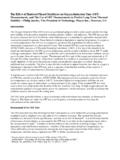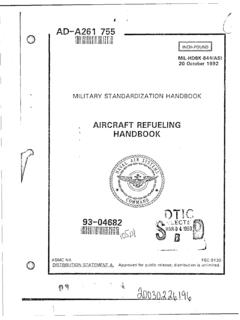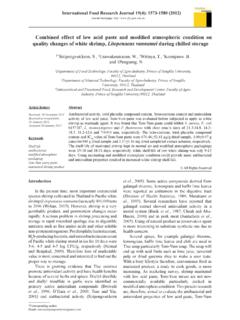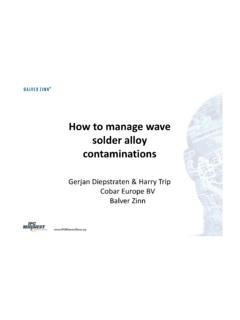Transcription of A Validated method for determination of …
1 IOSR Journal of Pharmacy and Biological Sciences (IOSR-JPBS) e-ISSN: 2278-3008, p-ISSN:2319-7676. Volume 9, Issue 5 Ver. III (Sep -Oct. 2014), PP 24-28 24 | Page A Validated method for determination of Metabisulfite content in Cetrizine Dihydrochloride and Ambroxol Hydrochloride 5+30mg/5mL syrup by Ion exchange chromatography. Swetha Parshaa,c* , Dr Y Ravindra kumara, Dr M Ravi chanderb , a Dr. Reddy's Laboratories Ltd., IPDO, Bachupally, Hyderabad-500072, , India. b Department of Chemisty, Mahatma Gandhi Institute of Technology, Hyderabad - 500072, A. P. India c Department of Chemisty, Jawaharlal Nehru Technological University, Hyderabad - 500072, A.
2 P. India Abstract: A commercial, particular and strong Ion Chromatography method was developed for the quantitative determination of metabisulfite content in Cetrizine Ambroxol syrup. The method was developed using Ion pac AS11HC Column, 250 X X m column with mobile phase containing 18mM sodium hydroxide in water. The eluted compounds were monitored using conductivity detector. The developed method was Validated as per ICH guidelines with respect to limit of detection(LOD), limit of quantification(LOQ), exactness, reproducibility, ruggedness and robustness. The LOD, LOQ values of metabisulfite were and respectively. Keywords: validation, quantitative determination , Ion Chromatography, Limit of detection, Limit of quantification, Sodium Metabisulfite.
3 I. Introduction Sodium metabisulfite also referred as Sodium pyrosulfite is with the chemical formula Na2S2O5. It is the antioxidant used in Cetrizine Ambroxol relief syrup. Sodium metabisulfite is used for stabilizing the relief syrup. It is the major excipient and preservative used in the syrup. Ambroxol ( ) is a secretolytic mediator used in the healing of respiratory diseases related with extreme mucus. Ambroxol is indicated as "secretolytic therapy in bronchopulmonary diseases associated with abnormal mucus secretion and impaired mucus transport. It promotes mucus clearance, facilitates expectoration and eases productive cough, allowing patients to breathe freely and deeply". Cetrizine ( ) is an antihistamine used in allergy treatment.
4 It is felt compulsory to have an Ion chromatography method for the quantitative estimation of Metabisulfite in Cetrine relief syrup. Currently, the determination of impurities and monitoring their level during the stability and the possible degradants or by-products during the stability is one of the most difficult tasks for pharmaceutical analysis during method development . Hence a stable and reproducible Ion exchange method was developed for the quantitative determination of Metabisulfite The samples were supplied by Dr Reddy s analytical research and development. International Conference on Harmonization (ICH) of analytical requirements guidelines has been followed for validating this method .
5 II. Experimental Materials and reagents Cetrizine Ambroxol syrup samples were provided by Dr. Reddy s Laboratories Limited, IPDO, Hyderabad, India. The analytical reagent (AR) grade Sodium metabisulfite and Sodium hydroxide were brought from Merck, Darmstadt, Germany. Chromatographic Conditions and Equipment IC was carried out on a Dionex Ion chromatography system equipped with Electrochemical detector model ICS5000DC, Autosampler model AS-AP, Gradient pump ICS5000SP with conductivity detection. This instrument is equipped with Variable Wavelength Detection, Electrochemical Detection consisting of Conductivity and Amperometry. Chromeleon software is utilized to detect the output signal.
6 The chromatographic column used was Ion pac AG11HC(guard) and AS11HC(Analytical), 250X , and 5 m particle size. The resolution was achieved on an isocratic method . The mobile phase composition contained 18mM Sodium hydroxide in IC grade water. The flow rate of mobile phase was mL/min . The column temperature was kept at ambient and the detection was performed utilising electrochemical detector. The diluent selected was Formaldehyde . Preparation of Stock Solutions A solution of Metabisulfite standard (1000ppm) was prepared by dissolving an appropriate amount of A Validated method for determination of Metabisulfite content in Cetrizine Dihydrochloride and.
7 25 | Page Sodium metabisulfite in diluent. An individual stock solution (10ppm) of Metabisulfite was prepared in diluent. III. method development and optimization The core aim of this effort is to build up a constancy indicating Ion chromatography method for determination of Metabisulfite content in Cetrizine Ambroxol relief syrup within shorter run time. Initially attempts were made by using different Ionpac columns (AG12A, AS12A, AS11, AG11) using different buffers ( Sodium tetraborate, Sodium hydroxide). In all above columns and intended experimental conditions, Metabisulfite was giving two peaks. The problem for the question why single standard is giving two peaks was not solved.
8 Attempts were made with column and mobile phase optimization. Experimentation proceeded as follows :Suspected column contamination, followed column washing procedure as per Dionex recommened manual and analysed the standard but the problem persists same. Suspected Metabisulfite standard contamination, hence looked for alternative lot but the same problem continued. Reveiwed the literature and found that Metabisulfite is stable in solid state but in aqeous solution it converts to sulfite, which on oxidation convets to sulfate. Practically injected the Metabisulfite 10ppm standard, Sulfite 10ppm standard and Sulfate 10ppm standard into ion chromatography system.
9 It is interestingly found out that first peak retention time of Metabisulfite is matching with Sulphite and second peak retention time of Metabisulfite is matching with Sulphate. Discussed regarding this with Dionex expert, and he suggested to use diluent as Formaldehyde, where the oxidation of metabisulphite to sulfate can be restricted. Analysed the standard using Formaldehyde as diluent, observed metabisulfite as major peak (peak area around ) but sulfate peak is seen still but area of the paek was negligible (around area). The negligible sulfate peak is attributed to the presence of minute traces of sulphate present in Metabisulfite standard solid itself. From practical experience found that it is necessary to prepare the diluents freshly before starting the analysis and will be stable for 24hours only.
10 Now the method is developed and injected the Cetrizine relief syrup samples but again the problem was standard is giving single paek for metabisulphite but samples are giving two peaks. The reason for this behavior was attributed to the explanation that as these samples are stability samples and aqeous solutions of Metabisulfite is already converted to Sulphite and Sulphate in the solution itself before injecting into IC system. Though Formaldehyde was used as diluent standard gave single peak but samples gave two peaks. This was further supported by practically injecting the placebo of Cetrizine sample with out metabisulfite and the placebo sample of fresh addition of Metabisulfite just before injecting into the IC system.















